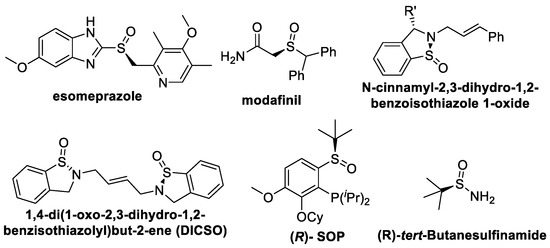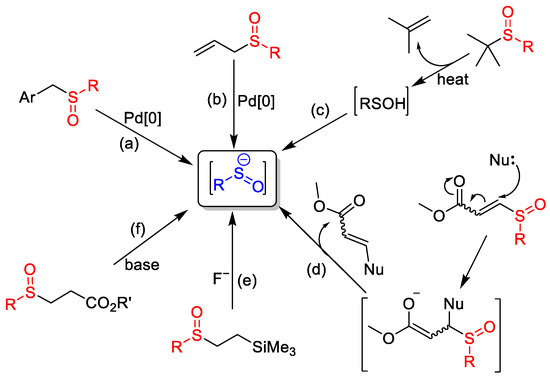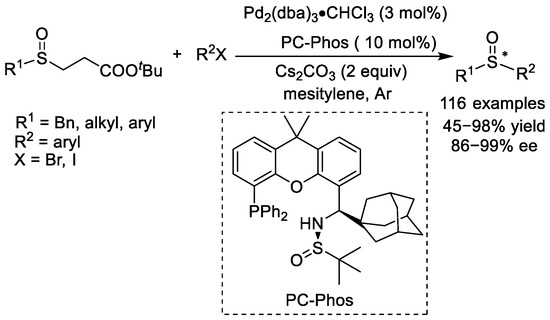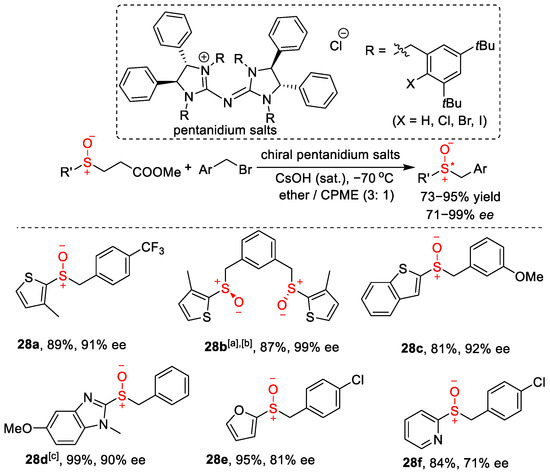You're using an outdated browser. Please upgrade to a modern browser for the best experience.
Please note this is a comparison between Version 1 by Qingle Zeng and Version 2 by Lindsay Dong.
Sulfoxides and sulfinamides play important roles in the pharmaceutical industry, organic synthesis and fine chemicals. Under catalysis by transition metals, β-sulfinyl esters, as nucleophilic reagents, react with a variety of electrophilic reagents to produce sulfoxides and sulfinamides.
- β-sulfinyl esters
- sulfenate anions
- sulfoxides
- sulfinamides
1. Introduction
Sulfoxides and sulfinamides have extensive applications in the pharmaceutical industry, organic synthesis, fine chemical industry and material production. They have shown a wide range of biological activities. More than 30% of chemicals contain sulfur components [1], such as the widely used proton pump inhibitors. The drugs in the proton pump inhibitor class contain a sulfoxide pharmacophore structure, among which Esomeprazole is a chiral sulfoxide molecule (Figure 1) [2]. The well-known drug Modafinil is also a type of sulfoxide (Figure 1) [3]. Both sulfoxides and sulfinamides are also key motifs in the chiral synthesis of chiral molecules, such as chiral auxiliaries, chiral ligands and organocatalysts [4].

Figure 1.
Some typical sulfoxides and sulfinamides.
It is well known that sulfenate anions (RSO−) [5][9] are the conjugate bases of sulfenic acids (RSOH) [6][10], and they demonstrate their peculiar S-nucleophilicity in various organic reactions. Sulfenate anions can be depicted by two limited valence bond structures, which can effectively elucidate the ambident nature of sulfenate anions, reacting as nucleophiles either at the sulfur atom or at the oxygen atom (Scheme 1).


Scheme 1.
Generation of sulfenate anions and their tautomerism.
Sulfenate anions are generally transient intermediates and must be generated in situ from a variety of sulfoxides (Scheme 2). One approach to obtaining sulfenate anions is via transition-metal-catalyzed transformations of benzyl (a) [7][11] and allyl (b) [8][12] and sulfoxides. However, it seems that transition-metal-free preparation methods are the better choice, for example, the pyrolyzation of tert-butyl aryl sulfoxides and then the base treatment of the resulting sulfenic acids (c) [9][10][13,14], the strong nucleophile-caused decomposition of 2-sulfinyl acrylates (d) [11][15], the fluoride-promoted desilylative fragmentation of 2-(trimethylsilyl)ethyl alkyl sulfoxides (e) [12][16] and the base-promoted retro-Michael reaction of β-sulfinyl esters (f) [13][17]. Among these generation methods, the preparation of sulfenate anions via the base-promoted retro-Michael reaction of β-sulfinyl esters (f) has developed most rapidly.


Scheme 2.
Some preparation methods of sulfenate anions.
In recent years, chemists have discovered that β-sulfinyl esters can generate sulfenate anions in situ under the action of alkali, and the latter can act as a nucleophile to react with an electrophile to generate sulfoxides and sulfinamides and other sulfur-containing compounds. Moreover, chiral sulfoxides can be synthesized from sulfenate anions.
β-Sulfinyl esters are generally obtained by the conjugated addition of thiophenols and acrylates to give thioether intermediates and then the further selective oxidation of the thioether intermediates. The general synthesis of β-sulfinyl esters is illustrated with 4-methylthiophenol as a specific starting reactant example (Scheme 3) [14][20].

2. Synthesis of β-Sulfinyl Esters and In Situ Generation of Sulfenate Anions

Scheme 3.
Typical synthetic method of
β
-sulfinyl esters.
β-Sulfinyl esters are easily deprotonated by inorganic bases, followed by retro-Michael addition to generate sulfenate anions (RSO−) in situ under mild conditions (Scheme 4) [13][17].


Scheme 4.
Alkali-induced in situ generation of sulfenate anion by
β
-sulfinyl esters.
3. Synthesis of Sulfoxides from β-Sulfinyl Esters
In 2006, Maitro et al. reported a method using palladium as a catalyst to catalyze the reaction of sulfenate anions generated in situ from β-sulfinyl carboxylic acid esters as nucleophiles to synthesize allyl sulfoxides (Scheme 5) [15][21]. During the reaction process, the sulfenate anion interacts with the instantaneously generated η3-allylpalladium complex to generate allyl sulfoxides and regenerate the Pd(0) catalyst.


Scheme 5.
Palladium-catalyzed synthesis of allyl sulfoxides.
When tert-butyl p-tolylsulfinylpropionate reacted with allyl acetate in the presence of the palladium complex, the corresponding allyl sulfoxide was obtained in an 82% yield. However, when tert-butyl p-tolylsulfinylpropionate reacted with cyclic allyl acetate, the yield of the product obtained was extremely low, possibly because steric hindrance had an impact on the reaction.
When tert-butyl 2-naphthylsulfinyl propionate was used as a raw material to react with allyl acetate compounds, only a 60% yield was obtained. Interestingly, cyclopent-2-enyl-acetate and cyclohex-2-enyl-acetate yielded 43% and 57% of the expected sulfoxides, respectively, when tert-butyl 3-isopropylsulfinylpropionate was adopted as the substrate. The reaction was carried out under biphasic conditions, which provides a simple, mild and efficient route for the synthesis of allyl sulfoxides.
More than ten years later, another new class of chiral ligands was found to perform well in the palladium-catalyzed synthesis of chiral sulfoxides. Until 2018, Zhang and co-workers reported the palladium-catalyzed asymmetric arylation of alkyl and aryl sulfenate anions with a new class of chiral ligands (Scheme 6Scheme 8) [16][24]. At first, they screened a few chiral ligands, but no satisfactory chiral ligands were suitable for this reaction. Inspired by the excellent performance of Xantphos for the racemic transformations of racemic sulfoxides, the authors used their PC-Phos ligand [17][25] with the same xanthene skeleton as Xantphos as a chiral ligand. After screening a series of chiral PC-Phos phosphine ligands, the PC-Phos bearing the bulky 1-adamantyl sulfinamide was found to be the best chiral ligand for the palladium-catalyzed synthesis of chiral diorganyl sulfoxides.


Scheme 68. Palladium-catalyzed asymmetric synthesis of chiral sulfoxides from alkyl and aryl sulfenate anions with chiral PC-Phos ligand. Note: * indicates that this atom (here is sulfur) has chirality.
In 2011, Gelat et al. described the chiral phase-transfer-catalyst-mediated asymmetric alkylation of β-sulfinyl esters with alkyl halides, which provided a new path for the synthesis of chiral sulfoxides (Scheme 7Scheme 11) [17][25]. When various alkyl halides were used to react with the corresponding sulfenate anions generated in situ from the corresponding β-sulfinyl esters, the desired sulfoxides were effectively obtained with certain enantioselectivities.


Scheme 711.
Synthesis of chiral sulfoxides via reaction of
β
-sulfinyl esters with alkyl iodides.
In 2014, the Tan group developed structurally novel chiral pentanidium salts with halogenated benzyl groups as phase-transfer catalysts (PTCs) for the enantioselective alkylation of sulfenate anions [18][27], which gave excellent results compared to commercially available PTCs (Scheme 8Scheme 13).


Scheme 813. Chiral pentanidium salts with halogenated benzyl groups as phase-transfer catalysts in asymmetric benzylation of (hetero)aryl sulfenate salts.
In 2007, Colobert et al. introduced the palladium-catalyzed heteroarylation of sulfenate anions [19][28], which could effectively synthesize heteroaryl sulfoxides. Afterward, Abarca and his collaborators also reported a related synthetic method [20][29]. Triazolopyridinyl sulfoxide, pyridinyl sulfoxide and thiophene sulfoxide could all be obtained at high yields under mild conditions from the reaction of the corresponding heteroaryl bromides with sulfenate anions (Scheme 9Scheme 14).


Scheme 914.
Heteroarylation of
β
-sulfinyl esters to synthesize heteroaryl sulfoxides.
4. Synthesis of Sulfinamides from
β-Sulfinyl Esters
In 2018, Dai’s group developed a method to construct sulfinamides via the copper-catalyzed electrophilic amination of sulfenate anions with N-benzoyloxyamines as an amination reagent (Scheme 10) [21]. This process was characterized by the capture of in situ generated sulfenate anions from
-Sulfinyl Esters
In 2018, Dai’s group developed a method to construct sulfinamides via the copper-catalyzed electrophilic amination of sulfenate anions with N-benzoyloxyamines as an amination reagent (Scheme 18) [33]. This process was characterized by the capture of in situ generated sulfenate anions from
β
-sulfinyl esters under mild conditions.


Scheme 108. Reaction of β-sulfinyl esters with amination reagents to synthesize sulfinamides.
When using
β
-sulfinyl esters with different structures, it was found that regardless of whether there was an electron-absorbing substituent or an electron-donating substituent on the aromatic ring, the corresponding negative sulfinyl ion could be effectively released. Methyl-substituted
β
-sulfinyl esters on the aromatic ring could give the target products with excellent yields, while the yields of
ortho
-methyl-substituted
β
-sulfinyl esters were significantly reduced, which suggests that steric hindrance had a negative effect on the reaction. The 2-naphthyl sulfenate anion precursor was also suitable for this reaction, efficiently providing the required sulfinamide.
5. Synthesis of Chiral Thioethers via Deoxidative Coupling Reaction of β-Sulfinyl Esters
Our research group recently discovered an unusual deoxidative coupling reaction of β-sulfinyl esters with benzylic trimethylammonium salts promoted by the strong base KOH (Scheme 11Scheme 19) [22][34], and various thioethers were produced. Enantiomerically enriched chiral quaternary ammonium salts synthesized from chiral amines afforded highly enantiomerically pure chiral benzyl thioethers (>95–99% ee). It seems that this reaction occurs via an SN2-type nucleophilic substitution process, since the chiral benzyl thioethers obtained had configurations opposite to those of the enantiomerically enriched amines.


Scheme 119.
Reaction of
β
-sulfinyl esters with amination reagents to synthesize sulfinamides.
6. Conclusions
β
-Sulfinyl esters prepared via the in situ formation of sulfenate anions under the action of alkali as a nucleophile, under catalysis by transition metals, can react with a variety of electrophiles. Among them, the most reported is the formation of sulfoxides, some of which were chiral sulfoxides synthesized with high enantiomeric purity. This has important practical significance, because a variety of important chiral drugs have structures of chiral sulfoxide moieties. Therefore, this synthetic method could provide another way to synthesize chiral drugs.
It is foreseeable that negative sulfinyl ions generated in situ by
β
-sulfinyl esters can react with carbocation species to synthesize chiral sulfoxides in the presence of chiral catalysts. This means that with a suitable chiral catalyst, sulfenate anions can also react with a variety of electrophiles, such as positively charged nitrogen, oxygen, phosphorus and sulfur species, to form various chiral sulfinyl-containing chiral compounds.
